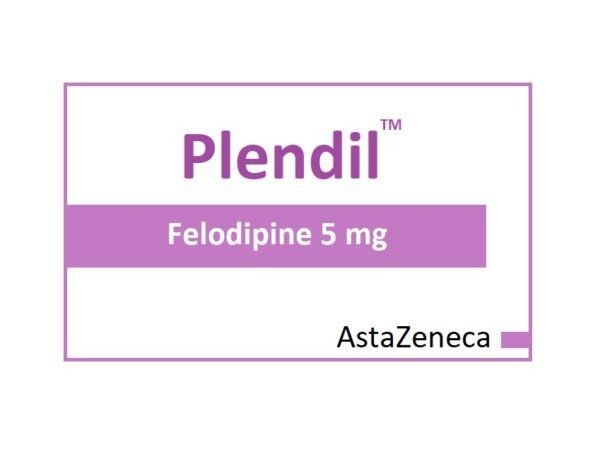
Side Effects of Plendil (felodipine)
Plendil (felodipine) is an oral calcium channel blocker (CCB) used to treat high blood pressure and prevent heart attacks and strokes. It may be used alone or in combination with other drugs. It can also be used to treat angina, although it is not FDA approved for this use.
Plendil works by preventing the release of calcium within muscle cells of the small arteries. This causes the muscles to relax and the arteries to dilate, reducing blood pressure. It has little to no effect on the muscles of veins or the heart.
Common side effects of Plendil include:
- Swollen ankles and feet
- Headache
- Flushing
- Dizziness
- Increased heart rate
- Low blood pressure
Serious side effects of Plendil include:
- Overgrowth of gums
- Rash
- Frequent urination
- Skin eruptions
- Palpitations
- Upper respiratory tract reactions
- Fainting
Plendil can interact with other drugs such as cimetidine, ketoconazole, itraconazole, and erythromycin, which may increase blood concentrations of Plendil and cause drops in blood pressure.
- Carbamazepine, phenobarbital, or phenytoin can lower Plendil blood concentrations.
- Taking Plendil with grapefruit juice increases its absorption and may cause sudden drops in blood pressure.
- Plendil may increase blood concentrations of tacrolimus.
- Tacrolimus blood concentrations should be monitored and the dose adjusted as necessary.
There is insufficient information on the effects of Plendil in pregnant women. The risks to the fetus must be weighed against the benefits to the mother.
It is unknown if Plendil is excreted in breast milk. Consult your doctor before breastfeeding.
What are the important side effects of Plendil (felodipine)?
The most common side effects reported by patients include:
- Swollen ankles and feet
- Headache
- Flushing
- Dizziness
- Increased heart rate
- Low blood pressure
Other important side effects include:
- Overgrowth of gums
- Rash
- Frequent urination
- Skin eruptions
- Palpitations
- Upper respiratory tract reactions
- Fainting
Plendil (felodipine) side effects list for healthcare professionals
In controlled studies, approximately 3000 patients were treated with felodipine. The most common adverse events reported with Plendil were peripheral edema and headache. Peripheral edema was generally mild and age and dose related. Discontinuation of therapy occurred in about 3% of patients due to peripheral edema, headache, or flushing.
- Adverse events that occurred with an incidence of 1.5% or greater at any recommended dose of Plendil (2.5 mg to 10 mg once a day) are listed by dose below.
- These events are reported from controlled clinical trials with patients who received a fixed dose of Plendil or were titrated from an initial dose of 2.5 mg or 5 mg once a day.
- Although the antihypertensive effect of Plendil is increased at 20 mg once a day, there is a disproportionate increase in adverse events, especially those associated with vasodilatory effects.
Percent of Patients with Adverse Events in Controlled Trials of Plendil (N=861) as Monotherapy (Incidence of discontinuations shown in parentheses)
| Body System Adverse Events | Placebo N=334 |
2.5 mg N=255 |
5 mg N=581 |
10 mg N=408 |
| Body as a Whole | ||||
| Peripheral Edema | 3.3 (0.0) | 2.0 (0.0) | 8.8 (2.2) | 17.4 (2.5) |
| Asthenia | 3.3 (0.0) | 3.9 (0.0) | 3.3 (0.0) | 2.2 (0.0) |
| Warm Sensation | 0.0 (0.0) | 0.0 (0.0) | 0.9 (0.2) | 1.5 (0.0) |
| Cardiovascular | ||||
| Palpitation | 2.4 (0.0) | 0.4 (0.0) | 1.4 (0.3) | 2.5 (0.5) |
| Digestive | ||||
| Nausea | 1.5 (0.9) | 1.2 (0.0) | 1.7 (0.3) | 1.0 (0.7) |
| Dyspepsia | 1.2 (0.0) | 3.9 (0.0) | 0.7 (0.0) | 0.5 (0.0) |
| Constipation | 0.9 (0.0) | 1.2 (0.0) | 0.3 (0.0) | 1.5 (0.2) |
| Nervous | ||||
| Headache | 10.2 (0.9) | 10.6 (0.4) | 11.0 (1.7) | 14.7 (2.0) |
| Dizziness | 2.7 (0.3) | 2.7 (0.0) | 3.6 (0.5) | 3.7 (0.5) |
| Paresthesia | 1.5 (0.3) | 1.6 (0.0) | 1.2 (0.0) | 1.2 (0.2) |
| Respiratory | ||||
| Upper Respiratory Infection | ||||
| Cough | 0.3 (0.0) | 0.8 (0.0) | 1.2 (0.0) | 1.7 (0.0) |
| Rhinorrhea | 0.0 (0.0) | 1.6 (0.0) | 0.2 (0.0) | 0.2 (0.0) |
| Sneezing | 0.0 (0.0) | 1.6 (0.0) | 0.0 (0.0) | 0.0 (0.0) |
| Skin | ||||
| Rash | 0.9 (0.0) | 2.0 (0.0) | 0.2 (0.0) | 0.2 (0.0) |
| Flushing | 0.9 (0.3) | 3.9 (0.0) | 5.3 (0.7) | 6.9 (1.2) |
| *Patients in titration studies may have been exposed to more than one dose level of Plendil. | ||||
Less common adverse events that occurred in 0.5% up to 1.5% of patients who received Plendil, and serious adverse events that occurred at a lower rate or events reported during marketing experience are listed below. These events are listed in order of decreasing severity within each category:
- Body as a Whole: Chest pain, facial edema, flu-like illness
- Cardiovascular: Myocardial infarction, hypotension, syncope, angina pectoris, arrhythmia, tachycardia, premature beats
- Digestive: Abdominal pain, diarrhea, vomiting, dry mouth, flatulence, acid regurgitation
- Endocrine: Gynecomastia
- Hematologic: Anemia
- Metabolic: ALT (SGPT) increased
- Musculoskeletal: Arthralgia, back pain, leg pain, foot pain, muscle cramps, myalgia, arm pain, knee pain, hip pain
- Nervous/Psychiatric: Insomnia, depression, anxiety disorders, irritability, nervousness, somnolence, decreased libido
- Respiratory: Dyspnea, pharyngitis, bronchitis, influenza, sinusitis, epistaxis, respiratory infection
- Skin: Angioedema, contusion, erythema, urticaria, leukocytoclastic vasculitis
- Special Senses: Visual disturbances
- Urogenital: Impotence, urinary frequency, urinary urgency, dysuria, polyuria
Gingival Hyperplasia
Clinical Laboratory Test Findings
Serum Electrolytes
- No significant effects on serum electrolytes were observed during short- and long-term therapy.
Serum Glucose
- No significant effects on fasting serum glucose were observed in patients treated with Plendil in the U.S. controlled study.
Liver Enzymes
- One episode of elevated serum transaminases decreased once the drug was discontinued in clinical studies; no follow-up was available for the other patient.


